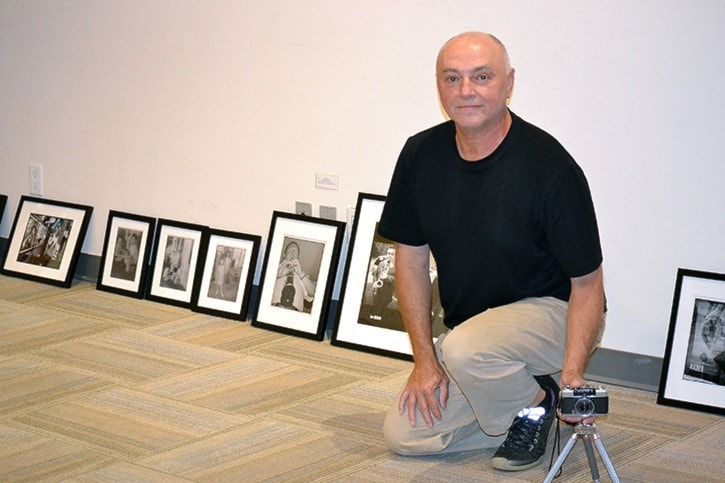There are three typical attitudes exhibited by the people who are the subjects of George Omorean's casual – yet artistically driven – travel photography.
One is unposed unawareness. Another is the reaction in the instant the subject realizes that he or she is being photographed. The third is a deliberate response to the camera, whether through motion or an impromptu pose.
In a series of shots taken of three men drinking on the street in Redfern, a notoriously rough suburb of Sydney, Australia, obliviousness fades into potential hostility, followed – swiftly and fortunately – by relaxed postures and hazy smiles.
"What I did was ask politely, 'would you mind if I took a photo?' and all of a sudden they're all, 'let's have another drink, mate'," the Peninsula-based photographer recalled.
"If I'd just grabbed a shot and moved on, it might have been very different."
Omorean delights in all three types of attitude – and the telling little things they reveal about the human condition, whether the subjects he's found are in Thailand or Romania, Central America or Australia.
Sometimes, in Omorean's new show, Half Camera Will Travel: Shooting From The Hip (White Rock Community Centre Gallery, until Aug. 27) we see all three as a narrative sequence.
In others, aspects of human interaction are only part of an arresting multiple-level juxtaposition, as in those instances when his focus is not only the advertising display in a storefront window but also the reflections on the glass itself – what he refers to as his "reflective" pieces.
Aiding Omorean in the process of creating these frequently gritty, black-and-white meditations, is the equipment he uses.
While he often travels with conventional digital cameras, the avid camera collector's real travel 'buddy' is an Olympus EE2 – a film camera manufactured in the 1968-1977 period.
The diminutive camera is an early example of the fixed-focus point-and-shoot philosophy, requiring only a basic exposure setting for the lighting conditions.
It's also an example of the relatively rare "half-frame" cameras that exposed only a vertical half-portion of the standard 35mm image, allowing for double the number of shots on the roll.
Hence, all of the compositions are vertical, although mounting several shots in sequence or interesting juxtaposition has created a horizontal flow to a number of the pieces in the current show, which features darkroom-printed, archival-quality silver gelatin photographs. (One horizontal is actually an entire roll of negatives mounted as a single backlit installation)
Omorean said he has found that the camera's small size – and the absence of prominent lens – makes it a subject-friendly instrument for his "shoot from the hip" method, particularly in situations like shooting the drinkers in Sydney, or some equally inebriated skinheads in Budapest.
The shutter is also virtually silent, which means he can shoot a few initial exposures before the subject is even aware of being photographed.
"I have no need to conceal it – it's a non-threatening, non-intimidating little camera," he said. "You can get right in the middle of the scene and when you're there you can get free, totally informal pictures."
He points to a sequence of shots of uninhibited couples gyrating on a dance floor in Limon, Costa Rica.
"Like this scene – I'm actually dancing with them," he said.
Omorean acknowledges that while the current show features his half-frame work exclusively, he likes to explore many facets and forms of art photography, finding new ways to blend conventional film, alternative process and digital imagery in everything from abstracts to portraits and landscapes.
Among influences have been the work of such masters as Diane Arbus and Cindy Sherman ("I like their raw style," he said), photojournalist Eugene Smith, Robert Frank, Alfred Stieglitz and Edward Steichen.
His love affair with photography began in 1977, he said.
"I was abroad, in Romania, for four years – studying health and physical education – but I took some photography courses at the University of Bucharest and started taking photographs then," he said.
Omorean's subjects range from children to street musicians to shamans – even bystanders at a Douglas Coupland exhibition at Vancouver Art Gallery – and whether they're aware of the camera or not, Ormorean is fascinated by the little insights into human nature they offer.
But shooting from the hip is not without its dangers, he noted.
"It's a little bit of a risk – more than once I've had the film ripped right out of my camera."
True to human nature, the extreme reactions don't always come from the subject – or perceived subject – he added.
"I was doing some photography on a beach one day, when all of a sudden this guy rushed up to me saying he didn't want his picture taken.
"I felt like saying, 'I wasn't even taking photos of you, anyway'."
The venue is located at 15154 Russell Ave.
Opening hours are 8:30 a.m. to 6 p.m. Monday through Thursday; 8:30 a.m. to 4:30 p.m. Friday and 9 a.m. to 1 p.m. Saturday.
For more information, call 604-541-2199.
